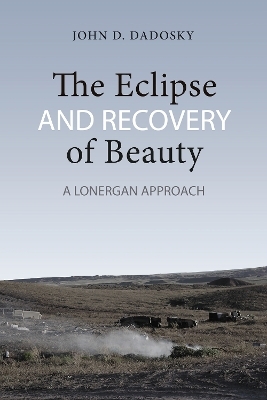
The Eclipse and Recovery of Beauty
University of Toronto Press (Verlag)
978-1-4875-2209-4 (ISBN)
- Lieferbar (Termin unbekannt)
- Versandkostenfrei innerhalb Deutschlands
- Auch auf Rechnung
- Verfügbarkeit in der Filiale vor Ort prüfen
- Artikel merken
Inspired by Bernard Lonergan’s philosophy of consciousness, Dadosky presents a philosophy of beauty that is grounded in contemporary Thomistic thought. Responding to Balthasar, he argues for a concept of beauty that can be experienced, understood, judged, created, contemplated, and even loved.
Deeply engaged with the work of Aquinas, Kierkegaard, Nietzsche, and Kant, among others, The Eclipse and Recovery of Beauty will be essential reading for those interested in contemporary philosophy and theology.
John D. Dadosky is a professor of philosophy and theology at the University of Toronto.
Preface
Introduction
1 The Eclipse of Beauty and Its Recovery
1.1 Introduction
1.2 The Achievement of Thomistic Metaphysics and its Demise
1.2.1 A Post-Kantian Transposition of Thomistic Metaphysics
1.3 Considerations for a Contemporary Philosophy of Beauty
1.4 Lonergan’s Philosophy and Hermeneutics: A Brief Overview
1.5 Conclusion
2 Every Being is Beautiful
2.1 Beauty as a Transcendental Property of Being
2.1.1 The Development of Transcendental Beauty
2.1.2 Aquinas and Transcendental Beauty?
2.1.3 The Fourth Period
2.2 Beauty: A Thomistic Interpretation
2.2.1 The Conditions of Beauty
2.2.2 Further Questions
2.2.3 Perception of Beauty
2.2.4 Beauty and Art
2.3. Beauty: A Lonergan Approach?
3 Violence and the Loss of Beauty
3.1 Displacement and Distortion of Beauty
3.2 Nietzsche’s Aesthetics
3.3 Girard’s critique of Nietzsche
3.3.1 Dionysus and the Crucified
3.3.2 Culpability in the Collective Murder
3.3.3 Dionysus as a Mimicked Distortion of Christ
3.4 A Re-orientation of Nietzchean Aesthetics?
3.5 Conclusion
4 Recovering Beauty in the Subject
4.1 Introduction
4.2 Kierkegaard’s Spheres of Existence
4.3 Balthasar’s Critique: A Closer Examination
4.4 The Existential Spheres and Intentional Consciousness
4.5 Conclusion
5 The End of Aesthetic Experience?
5.1 Introduction
5.2 The Loss of Aesthetic Experience
5.2.1 Major Post-Kantian Approaches to Aesthetic Experience
5.2.2 Shusterman: “The End of Aesthetic Experience”
5.3 Lonergan and Aesthetic Experience
5.3.1 The Unrestricted Desire for Beauty
5.3.2 Freedom from Instrumentality
5.3.3 Elemental Meaning
5.3.4 Ulterior Significance and ‘Surplus of Meaning’
5.3.5 Transformative and Distortive aspects of Aesthetic Experience
5.3.6 Lonergan and Shusterman
5.4 The Sensible and Intellectual Perception and Apprehension of Beauty
5.5 Aesthetic Experience and the Sublime
5.1 Brief History of the Sublime
5.2 The Sublime as Experienced
5.6 Conclusion
6 The Intelligibility of Beauty
6.1 Introduction
6.2 Beauty and Architecture: The example of Christopher Alexander
6.2.1Alexander’s 15 principles
6.2.2 Alexander’s principles and Aquinas
6.3 The Intelligibility of Beauty in Lonergan’s Theory of Consciousness
6.4 Conclusion
7 Judgments of Beauty
7.1 Introduction
7.2 Aesthetic Judgments in Kant
7.2.1 Four Moments of Aesthetic Judgments
7.3 Lonergan and Judgment
7.3.1 ‘Value’ in Method in Theology
7.4 Judging Beauty for Lonergan
7.4.1 A Lonergan Appropriation of Kant’s Four Moments
7.4.2 Beauty and the Preferential Scales of Values
7.4.3 Three Moments of Beauty
7.4.4 Is Beauty distinct from Goodness?
7.5 Concluding Comments
8 Creating, Contemplating and Loving Beauty
8.1 Introduction
8.2 The Aesthetic/Dramatic Operator
8.3 Philosophy of Art
8.3.1Aesthetic and Artistic patterns of experience
8.3.2 Art as Meaning
8.3.3Developing Lonergan on Art
8.3.4 Summing up: Lonergan on Art
8.4 Life and Beauty
8.4.1Ethical living
8.5 Contemplating Beauty
8.6 Loving Beauty
8.7 Beauty and God
7.1 From Aesthetic Experience to the Beauty of God
8.8 Conclusion
9 Philosophy for a Theology of Beauty
9.1 Introduction
9.2 A Summary and Overview
9.3 Towards a Theology of Beauty
9.4 Conclusion
| Erscheinungsdatum | 31.05.2017 |
|---|---|
| Reihe/Serie | Lonergan Studies |
| Verlagsort | Toronto |
| Sprache | englisch |
| Maße | 152 x 229 mm |
| Gewicht | 410 g |
| Themenwelt | Geisteswissenschaften ► Philosophie ► Erkenntnistheorie / Wissenschaftstheorie |
| Geisteswissenschaften ► Philosophie ► Ethik | |
| Geisteswissenschaften ► Religion / Theologie | |
| ISBN-10 | 1-4875-2209-6 / 1487522096 |
| ISBN-13 | 978-1-4875-2209-4 / 9781487522094 |
| Zustand | Neuware |
| Haben Sie eine Frage zum Produkt? |
aus dem Bereich

![Was heißt Denken?. Vorlesung Wintersemester 1951/52. [Was bedeutet das alles?] - Martin Heidegger](/media/113619842)
